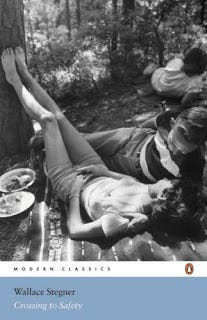Crossing to Safety - from the end

I finished Crossing to Safety, by Wallace Stegner, the other evening. Oh how I cried and cried.
The “plot” of this book is simple. It’s about two couples, Sid and Charity Lang and Larry and Sally Morgan, who meet when both husbands are young lecturers at a university, and both wives are pregnant. The book, narrated by Larry and largely autobiographical for Stegner, follows the course of their friendship and their marriages throughout the years, through their ordinary joys and sorrows, through a year of peace and friendship and pleasant adventures shared together in the history and beauty of Florence, till they come together many years later when Charity is dying of cancer.
There is no very great excitement in the story. Larry himself, commenting on Americans who settled on the Left Bank in Paris, narrates:
They had had only a war to damage them, and war’s damage is, when it isn’t fatal, likely to be stimulating rather than the reverse. Living through a war, you have lived through drama and excitement. Living through what we had been given to live through, we had only bad luck or personal inadequacy to blame for our shortcomings.
Whatever you think of the truth of that statement (and I am glad I don’t believe in “bad luck”), it describes this novel. And yet it is a story about people, about relationships, about characters and how they grow and change or don’t change. And those are the stories I like best.
Larry and Sally suffer the misfortunes of circumstances more severely, yet their marriage is harmonious, sympathetic and tender. Sid and Charity have all the blessings circumstances can give, and you come to love them both, but their marriage is, as one son-in-law later describes it, “... mutual crucifixion. They aren’t individuals, they’re confrontation. They’re an insoluble dilemma ...”.
In the end I cried, not for the dying Charity, but for Sid, whose marriage was “a kind of slavery” but one that he “couldn’t bear to part with”, and for Sally, the suffering saint, and for relationships that can grip us so closely and yet hurt so terribly.
I was a little dissatisfied with the ending. I was hoping for a metaphorical “crossing to safety” for Sid and Charity, a moment of self-awareness for Charity when she would relent and soften from her arrogance of believing she always knew what was best for people, and from her tyrannical insistence that they act her script. But their marriage ended as it had always been, which is no very great surprise, yet it was heart-breaking.
It’s a beautiful piece of writing. Wallace Stegner won the Pulitzer in 1972, proof that he knows how to thread one sentence after another in pleasing array, and so if you like the stories of other lives told well, you will like this book.
I am now keen to read Angle of Repose, the novel for which Stegner won the Pulitzer.

